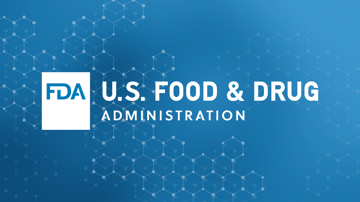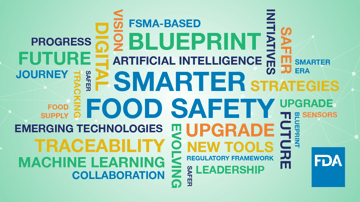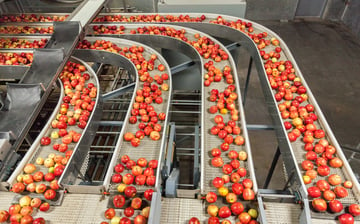Zebra Technologies and FoodLogiQ discuss how RFID is shaping the modernization of the food supply chain, and what food system stakeholders are doing to prepare for new regulations.
Last year, the FDA launched a new forward-looking campaign to drive long-term adoption and consensus around supply chain modernization. The New Era of Smarter Food Safety initiative is a major step towards building a tech-enabled food system through incremental changes in culture, proliferation of new technologies, and clarity around interoperable standards. Many of these changes will soon be codified in updates to the Food Safety Modernization Act (FSMA) section 204, which have been outlined in a proposed traceability rule published in September 2020.
Longtime partners FoodLogiQ and Zebra Technologies recently released new functionality as part of the FoodLogiQ Connect Winter Release in order to achieve a more efficient and effective food technology ecosystem. FoodLogiQ Director of Content and Growth Marketing Anna Ploegh sat down with Zebra Technologies Director of RFID Business Development Susan Flake and FoodLogiQ VP of Supply Chain Strategy and Insights Julie McGill to discuss how RFID is shaping the modernization of the food supply chain, as well as how supply chain digitization will enable food companies to better participate in the New Era.
AP: Let’s start really simple: can you explain to me the basic form and function of RFID? What do the tag, reader and cloud data storage bring to the table, respectively?
SF: The basic premise for the reader and for the tags is simple. The reader emits energy that wakes up an RFID tag, which in turn sends its data back to the reader. That’s a complete cycle of data exchange. The benefit of collecting data via RFID is a) no line of site is required and b) the speed and accuracy of which data can be collected.
JMcG: Capturing data through a read, instead of line-of-site scanning is a game changer which has benefits for inbound, outbound and in-house operations. With that data capture, storing the information on the cloud levels the playing field for all trading partners, providing access to Key Data Elements that can be used for reporting, inventory visibility, and supply chain management.
AP: We’re seeing more adoption, pilot programs and interest in the technology than ever. What are the key trends and motivators driving RFID adoption within the food industry?
SF: A major driver is being able to garner inventory visibility at a granular level, and at a much faster pace and with greater accuracy. These gains enable store associates to garner back face time with customers, as opposed to spending their time doing manual tasks with pencils and paper.
The inaccuracy of pencil and paper is a real issue. Typically, that takes a much longer timeframe to collect the data, you're often interrupted and may lose track of where you were in data collection, which then has to be key entered into a backend system; these conditions produce opportunities for errors to occur. So, you have two points of failure, which leads to inaccurate data and providing accuracy levels somewhere in the neighborhood of about 75% on average, in the QSR industry. The value of RFID is that it takes you to over 99% accuracy levels.
AP: Where in the food supply chain is RFID used? How does flow of data work and benefit retailers, manufacturers, suppliers and operators?
SF: RFID is being used from the supplier or manufacturer, and being applied at the source flowing through to distribution, and then flowing out to the restaurant. There's six key read points along this journey. For example, for suppliers, at point of production and shipping. At distribution, read points are at receiving and shipping. And at the retailer, it's a receiving event and an inventory or storage event.
The key benefits for the supplier is that authentication at the source which increases customer confidence, and leads to more effective recalls. It provides a path for suppliers to connect to the end-consumer with a brand story, as well as having compliance with evolving government regulations, such as FSMA.
At distribution, the benefits can include the elimination of manual scanning for inventory and providing improved inventory accuracy, the ability to manage expiration dates more effectively, as well as increased traceability by knowing what came into distribution and what is flowing out. Lastly, order delivery accuracy: knowing that they're putting the right product on the right truck to be delivered to each of the restaurants or food retailers that they are servicing.
The benefits for the retailer include not only labor savings, but optimization of the food product that they have in-house, in turn reducing food waste, and really providing a better customer experience. Another key benefit is enabling more accurate and speedy recall management, as you have the inventory at the case granular level.
There are similar benefits at the quick service restaurant. The average QSR has about 300 cases back of house. By pencil and paper, they're taking roughly an hour to take inventory and key into a backend system. We work with QSRs that are counting critical items three times a day, and are taking full inventories at night. They may also do an opening inventory, a weekly inventory, as well as a monthly inventory of everything, including supplies. With RFID, they're able to take that hour down to about five minutes, counting as often as they would like with very accurate results.
All of this in turn leads to less waste, better margin protection, and being able to surgically remove a product and have a more effective recall.
AP: All these stakeholders need to be on the same page. What role do standards play in RFID and the use of digitized data?
SF: RFID follows the GS1 standard across the board, regardless of vertical. Within the food industry, we're leveraging the GS1-128 label, which includes the GTIN, the date and the lot for the RFID tag. There are some GS1 workgroups that are looking to see how we can add additional data and extended attributes and generate new standards around more elements.
The reason you want to use GS1 standards is for interoperability, so that suppliers are able to send cases into the distributor and into the restaurant using one common language. That's what standards enable.
JMcG: FoodLogiQ is also committed to data sharing and interoperability through our open APIs and is participating in programs such as the GS1 US Interoperability Proof-of-Concept (POC). Working side by side with GS1 US and other major technology partners, this group is leading the way to exchange information about a product’s journey across various platforms and systems, using EPCIS. For years, industry partners have expressed concerns about data “silos” and this POC is proving that data can be shared securely and efficiently, using GS1 standards.
AP: As part of our latest release, FoodLogiQ has added the ability to parse RFID labels for traceability data utilizing the FoodLogiQ mobile application. With this functionality, RFID labels are read using the Zebra RFD8500 device, at which point traceability event data is transferred into FoodLogiQ’s mobile app. Why is this digitization from RFID to the cloud so important?
SF: It's really about two critical items: speed and accuracy.
Being able to take inventory, locate and remove a product within minutes from the supply chain minimizes disruption and the costs that may be incurred, in addition to protecting the brand’s reputation. It's also about accuracy. Enabling a 99% digital supply chain eliminates the paper trail and manual roadblocks, and puts confidence into knowing your inventory first. This means you always know what products are where. Food recalls should be so granular that you're able to pull products from select stores, as opposed to sending out a mass recall.
AP: I'm always blown away by the magnitude of food waste throughout the supply chain. It's really a little heartbreaking.
SF: 40% of everything we grow gets thrown away. And, it's actually trending in the wrong direction. 10 years ago, that number was at 30%, but it continues to grow and has created problems within our landfills. Food is the largest contributor to landfills. And, we have hungry people. So how do we reduce the waste, address food insecurity and help the people who need food?
AP: The first step is visibility and actionable data, which can be daunting to some. Let’s talk a little bit about how to get started. Especially for food companies looking to prepare for new or updated regulation like FSMA 204, what are some important first steps?
SF: Get all of the stakeholders involved in the project early on, determine your KPIs and ROI up front. For RFID, start off with inventory visibility as your main objective. It is the foundation on which all the other use cases will build upon.
JMcG: Having a solid vision in place is the first step, next is determining how you will get there and when. Engaging RFID partners will help you enable the data capture, traceability solution providers can help you store and make sense of the data, so it is available and actionable. The most successful programs include partners who can work collaboratively and seamlessly to bring your vision to life.
AP: And how will RFID enable food companies to achieve the potential recordkeeping requirements outlined within the proposed traceability rule?
SF: RFID gives you a digital identity to an individual case, enabling digitalization of that data immediately. So, if you need to supply information back to the FDA within 24 hours, it's ready and available in near real time.
If you're a restaurant, you would be able to refuse tainted product if it's coming in as a new receipt. If you're a distributor or supplier, you’re able to pull it before it hits the restaurant or gets shipped.
JMcG: Pending regulations, such as the proposed FSMA 204 rule, are setting the stage for batch/lot level traceability requirements. This will require the capture, storage and maintenance of extended traceability attributes for products on the FDA’s Food Traceability List. This data will need to be stored for 24 months, and if requested, trading partners need to be prepared to share requested data with the FDA within 24 hours. This will take a coordinated effort by all trading partners across the supply chain to determine how they will meet these proposed regulations.
AP: The FDA also has recently launched the New Era of Smarter Food Safety initiative. How will an integrated tech ecosystem that leverages RFID help achieve this vision, and enable other innovations in areas such as machine learning?
SF: We see them as complementary enabling technologies, as opposed to competing technologies. Much like the barcode and RFID, they're complimentary to each other and one is not going to displace the other but together make for a more powerful solution.
Being able to leverage machine learning and analytics based on RFID data can provide new insights into inventory and the safety of a company’s products. Overall, a strong tech ecosystem can help make a better food supply chain, reduce waste, create labor savings and enable a more efficient supply chain.
AP: This year, we’ve seen the importance of visibility and resilience. How can RFID help companies navigate crises like the COVID-19 pandemic?
SF: RFID is hands off, so no one is touching the product, but they're being able to take inventory. That’s frictionless and COVID-safe.
More broadly, RFID leads to agility. At the beginning of the pandemic we saw a lot of grocery stores with empty shelves, and it took a long time for the supply chain to get product back into the stores. With increased visibility, supply chains will be able to move product in a more efficient manner, reducing out-of-stocks, and adjusting quickly to those consumer pivots and behaviors that we are seeing today. These trends will continue beyond COVID. It will continue to be important to be able to react quicker than what our traditional supply chain methods have enabled today.
JMcG: Food companies have been exploring the use of RFID in many creative and exciting ways. Some are using it only in the restaurant or store, while others have expanded to their distributor and supplier partners. The use cases are endless, and benefits can be realized at all points in the supply chain. In today’s food systems, frictionless, accurate, efficient automation is imperative, and gathering data at all of these read points is critical in order to meet internal needs and regulatory requirements. We are looking forward to further collaboration with Zebra to take our customers into this new era of food safety and traceability through data capture technologies such as RFID.
FoodLogiQ and Zebra Technologies will be presenting on these topics at FoodLogiQ's upcoming user group conference, reCONNECT 2021. Register today.
Other posts you might be interested in
View All Posts
Traceability
10 min read
| February 25, 2021
FoodLogiQ Commentary on the FDA's FSMA 204 Proposed Rule
Read More
Food Safety
5 min read
| December 18, 2019
A New Era of Smarter Food Safety Public Comments
Read More
Trustwell News
6 min read
| December 17, 2021

